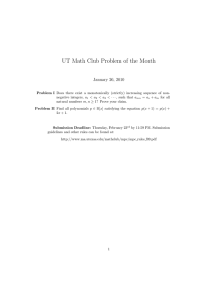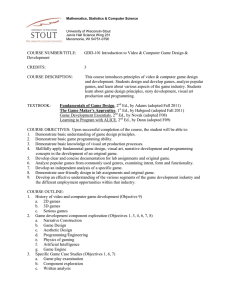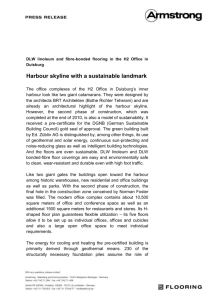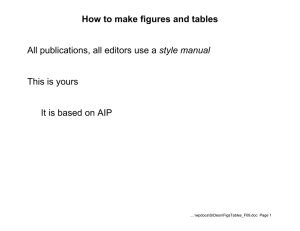CS61CL Machine Structures – Introduction to Digital Design Lec 7 David Culler
advertisement
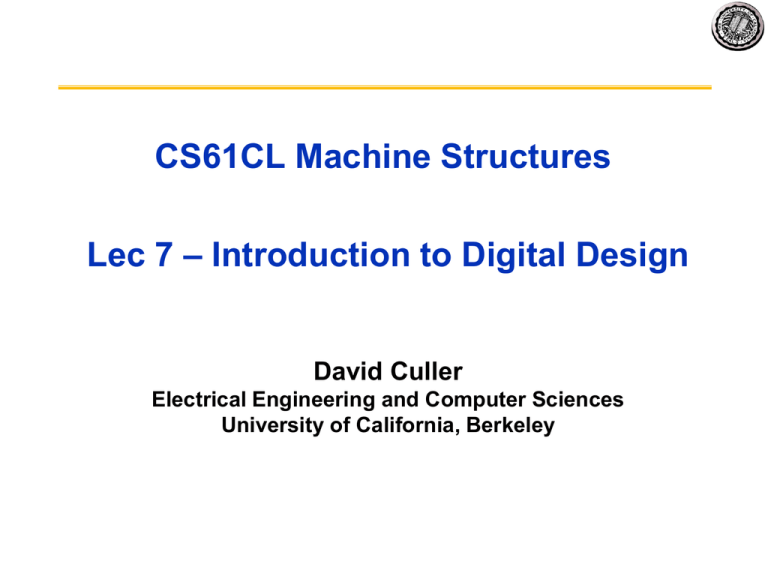
CS61CL Machine Structures Lec 7 – Introduction to Digital Design David Culler Electrical Engineering and Computer Sciences University of California, Berkeley CS61CL Road Map HLL Program Asm Lang. Pgm Machine Lang. pgm foo.s foo.c foo.exe foo.o Software Instruction Set Architecture Hardware Machine Organization Instr. Set Proc. I/O system Datapath & Control Digital Design Circuit Design Layout & fab Semiconductor Materials 10/14/09 CS61CL F09 2 Linking Object file exe file Code 32: J ____ 60: J _32_ 80: LW _16_ 360 Object file 20: 20: SW $ra, 16($sp) Data 100 16: 0610 20 Symbol table SW $ra, 16($sp) 20 132: J ____ 160: J _32_ 132 180: LW _16_ 396 ref “foo” ext 32 def “bar” int 32 def “foo” int 20 ref “bar” int 60 … 0610 ref “xyz” int 80 ddef “xyz” int 16 • Resolve names to addresses • Relocate code and data blocks – Adjust internally resolved addresses 10/14/09 CS61CL F09 3 Questions 10/14/09 CS61CL F09 4 Evolution of Instruction Sets Single Accumulator (EDSAC 1950) Accumulator + Index Registers (Manchester Mark I, IBM 700 series 1953) Separation of Programming Model from Implementation High-level Language Based (Stack) (B5000 1963) Concept of a Family (IBM 360 1964) General Purpose Register Machines Complex Instruction Sets Load/Store Architecture (CDC 6600, Cray 1 1963-76) (Vax, Intel 432 1977-80) RISC iX86? 10/14/09 (MIPS,Sparc,HP-PA,IBM RS6000, 1987) CS61CL F09 5 Dramatic Technology Advance • Prehistory: Generations – – – – 1st Tubes 2nd Transistors 3rd Integrated Circuits 4th VLSI…. • Discrete advances in each generation – Faster, smaller, more reliable, easier to utilize • Modern computing: Moore’s Law – Continuous advance, fairly homogeneous technology 10/14/09 CS61CL F09 6 Moore’s Law • “Cramming More Components onto Integrated Circuits” – Gordon Moore, Electronics, 1965 • # on transistors on cost-effective integrated circuit double every 18 months 10/14/09 CS61CL F09 7 Example: Intel Pentium 10/14/09 CS61CL F09 8 Integrated Circuits • • • • • • • Primarily Crystalline Silicon 1mm - 25mm on a side 100 - 200M transistors (25 - 50M “logic gates") 3 - 10 conductive layers 2002 - feature size ~ 0.13um = 0.13 x 10-6 m “CMOS” most common complementary metal oxide semiconductor Chip in Package • Package provides: – spreading of chip-level signal paths to board-level – heat dissipation. • Ceramic or plastic with gold wires. 10/14/09 CS61CL F09 9 Integrated Circuits • Uses for digital IC technology today: – standard microprocessors » used in desktop PCs, and embedded applications » simple system design (mostly software development) – memory chips (DRAM, SRAM) – application specific ICs (ASICs) » custom designed to match particular application » can be optimized for low-power, low-cost, high-performance » high-design cost / relatively low manufacturing cost – field programmable logic devices (FPGAs, CPLDs) » customized to particular application after fabrication » short time to market » relatively high part cost – standardized low-density components » still manufactured for compatibility with older system designs 10/14/09 CS61CL F09 10 Switches: the basic element • Implementing a simple circuit: A Z close switch (if A is “1” or asserted) and turn on light bulb (Z) A Z open switch (if A is “0” or unasserted) and turn off light bulb (Z) Z A 10/14/09 CS61CL F09 11 Physical world to Digital world Technology State “0” State “1” Relay logic Circuit Open Circuit Closed CMOS logic 0.0-1.0 volts 2.0-3.0 volts Transistor transistor logic (TTL) 0.0-0.8 volts 2.0-5.0 volts Fiber Optics Light off Light on Dynamic RAM Discharged capacitor Charged capacitor Nonvolatile memory (erasable) Trapped electrons No trapped electrons Programmable ROM Fuse blown Fuse intact Bubble memory No magnetic bubble Bubble present Magnetic disk No flux reversal Flux reversal Compact disc No pit Pit Sense the logical value, manipulate in a systematic fashion. 10/14/09 CS61CL F09 12 The Digital Abstraction +3 Logic 1 V Logic Gate 0 Logic 0 • Logical 1 (true) : V > Vdd –V th • Logical 0 (false) : V < Vth • Logical Gates – behave like boolean operators on these voltage signals – Produce signals that can be treated as logical values 10/14/09 CS61CL F09 13 CMOS “Devices” • MOSFET (Metal Oxide Semiconductor Field Effect Transistor) Top View Cross Section nFET • Essentially a voltage-controlled switch • N: closed when gate is Hi • P: closed when gate is Lo 10/14/09 CS61CL F09 pFET 14 Transistor-level Logic Circuits (inv) • Inverter (NOT gate): Vdd Gnd what is the relationship between in and out? in 10/14/09 Vdd out 0 volts 3 volts 3 volts 0 volts CS61CL F09 Gnd 15 Example: NOT +3 not( out, in) in out F T T F Logic 0 Input Voltage Vout Logic 1 Input Voltage 0 Vin 10/14/09 CS61CL F09 +3 16 Big idea: Self-restoring logic • CMOS logic gates are self-restoring – Even if the inputs are imperfect, switching time is fast and outputs go “rail to rail” – Doesn’t matter how many you cascade » Although propagation delay increases • Limit fan-out to ensure sharp and complete transition 10/14/09 CS61CL F09 17 Combinational Logic Symbols • Common combinational logic systems have standard symbols called logic gates A B – Buffer, NOT A Z A B 10/14/09 0 0 0 0 1 0 1 0 1 1 1 1 1 Z Easy to implement with CMOS transistors (the switches we have available and use most) – OR, NOR A B A+B 0 10 – AND, NAND A*B Z CS61CL F09 18 more Boolean Expressions to Logic Gates • NAND • NOR X Y X Y • XOR X Y • XNOR X=Y X Y X Y 10/14/09 Z X 0 0 1 1 Y 0 1 0 1 Z 1 1 1 0 Z X 0 0 1 1 Y 0 1 0 1 Z 1 0 0 0 Z X 0 0 1 1 Y 0 1 0 1 Z 0 1 1 0 Z X 0 0 1 1 Y 0 1 0 1 Z 1 0 0 1 CS61CL F09 X xor Y = X Y' + X' Y X or Y but not both ("inequality", "difference") X xnor Y = X Y + X' Y' X and Y are the same ("equality", "coincidence") 19 Administration • Great job on Mid Term – Mean: 79%, Median: 82%, Min: 36, Max: 99 (3) • Project 2 is due Monday 10/26 – Work in pieces » call snprintf / save / restore / rtn » copy format to buffer respecting bufferSize » dispatch to one format function » add other format functions • Homework 6 out tonight 10/14/09 CS61CL F09 20 Relationship Among Representations * Theorem: Any Boolean function that can be expressed as a truth table can be written as an expression in Boolean Algebra using AND, OR, NOT. unique ? Truth Table not unique Boolean Expression ? gate representation (schematic) [convenient for manipulation] not unique [close to implementaton] How do we convert from one to the other? 10/14/09 CS61CL F09 21 Recall: Addition +15 +14 1111 +0 1110 +13 Example: 3 + 2 = 5 +1 0000 0001 + 1101 +2 0010 Is just addition, base 2 +12 1100 0011 +3 +11 1011 0100 +4 1010 0101 +10 1001 +9 Add the bits in each position and carry +5 0110 1000 +8 10/14/09 Unsigned binary addition 0111 1 0011 + 0010 +6 0101 +7 CS61CL F09 22 Design an Adder 1 1 Ci A B Co S 0 0 0 0 0 + 0011 0 0 1 0 1 0110 0 1 0 0 1 0 1 1 1 0 10 0 0 1 1 0 1 1 0 1 1 1 1 1 0011 A B Ci A B Ci A B Ci A B Ci Co S Co S Co S Co S 10/14/09 CS61CL F09 23 Element of Time +3 Propagation delay Vout 0 T • Logical change is not instantaneous • Broader digital design methodology has to make it appears as such – Clocking, delay estimation, glitch avoidance 10/14/09 CS61CL F09 24 What makes Digital Systems tick? Combinational Logic clk time 10/14/09 CS61CL F09 25 Synchronous Circuit Design clock input input CL CL reg reg output option feedback output • Combinational Logic Blocks (CL) – Acyclic • clock – no internal state (no feedback) – output only a function of inputs • Registers (reg) – distributed to all flip-flops • ALL CYCLES GO THROUGH A REG! – collections of flip-flops 10/14/09 CS61CL F09 26 Modern Hardware Design • Extremely Software Intensive – – – – – Design tools (schematic capture, hardware description lang.) Simulation tools Optimization tools Verification tools Supply chain and project management • Managing complexity of fundamental – – – – Modularity Methodology Clarity Technology independence • Push the edge – Of the available tools – Of the technology 10/14/09 CS61CL F09 27 Basic Design Tradeoffs • You can usually improve on one at the expense of one or both of the others. • These tradeoffs exist at every level in the system design - every sub-piece and component. • Design Specification – Functional Description. – Performance, cost, power constraints. • As a designer you must make the tradeoffs necessary to achieve the function within the constraints. 10/14/09 CS61CL F09 28
